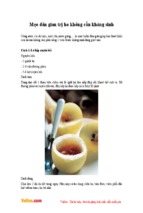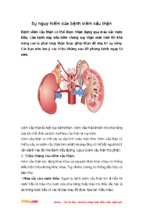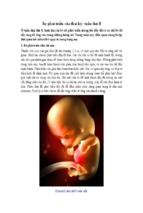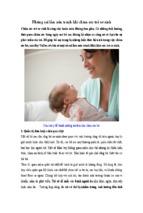VOJNOSANITETSKI PREGLED
Page 1
UDC: 616.24-006-085
DOI: 10.2298/VSP160125117S
ORIGINAL ARTICLE
Quality of life in patients with non-small cell lung cancer
Kvalitet života bolesnika sa nesitnoćelijskim karcinomom pluća
Sanja Šarac*†, Rade Milić*†, Mira Vasiljević*, Momir Šarac†‡
*Clinic for Pulmonology, ‡Clinic for Vascular and Endovascular Surgery, Military
Medical Academy, Belgrade, Serbia; †Faculty of Medicine of the Military Medical
Academy, University of Defence, Belgrade, Serbia
Abstract
Apstrakt
Background/Aim. As lung cancer is considered the greatest
contributor to death among all cancer types any help might
be valuable in the assessment of treatment effects. The aim of
this study was for assess the quality of life (QoL) in patients
with non-small cell lung cancer (NSCLC) treated with gemcitabine-cisplatin regimen as the first line of chemotherapy.
Methods. The QoL was assessed using certified Serbian
translations of the European Organization for Research and
Treatment of Cancer Quality Life Questionnaire Core 30
(EORTC QLQ-C30) and Lung Cancer Module (QLQ-LC13)
– version 3. The questionnaire was used before starting
treatment and after the completion of the 2nd and the 4th cycle of chemotherapy. The questionnaire scales and single
items were compared in order to assess the impact of treatment on the QoL. Results. A total of 60 patients started and
51 completed all questionnaires. There were no changes in
the global health status score between the baseline, the 2nd
and the 4th cycle of chemotherapy (42.78 ± 15.76, 45.56 ±
17.59, 48.20 ± 19.24, respectively; p = 0.1). Social function
score, symptom scores: nausea and vomiting, pain, appetite
loss, constipation, diarrhea and financial difficulties score differed significantly among chemotherapy cycles, indicating
improved or worsened the QoL. In the lung cancer symptom
score a significant difference between measurements was observed in cough, alopecia, chest pain and in using analgesics.
Conclusion. Monitoring of changes in the QoL among patients with locally advanced and metastatic NSCLC showed
that chemotherapy did not decrease the global health status
but led to significant changes in the social and financial functioning of patients. Some symptoms associated with the disease reduced in the intensity but some new occurred as a result of chemotherapy. Using questionnaires to assess the QoL
helped in easier identification of adverse effects and specific
problems for adequate treatment.
Uvod/Cilj. S obzirom na činjenicu da je karcinom pluća najsmrtonosniji među svim karcinomima, dragocena je svaka
pomoć u proceni efekta lečenja. Cilj ove studije bio je da se
proceni kvalitet života (quality of life – QoL) obolelih od nesitnoćelijskog karcinoma pluća (NSCLC) koji su lečeni prvom
linijom hemioterapije po protokolu gemcitabin-cisplatin. Metode. QoL procenjivan je primenom sertifikovane srpske
verzije upitnika Evropske organizacije za istraživanje i lečenje
karcinoma (EORTC QLQ-C30) i dodatka koji se odnosi na
karcinom pluća (EORTC QLQ-LC13) – verzija 3. Bolesnici
su ispunjavali upitnik pre započinjanja lečenja i nakon kompletiranja drugog i četvrtog ciklusa hemioterapije. Rezultati su
poređeni kako bi se procenio uticaj lečenja na kvalitet života
bolesnika. Rezultati. Ukupno 60 bolesnika bilo je uključeno
u istraživanje, a 51 je popunio sve upitnike. Nije bilo statistički značajnih promena ukupnog QoL između vremena pre početka lečenja, nakon drugog i nakon četvrtog ciklusa hemioterapije (42,78 ± 15,76, 45,56 ± 17,59, 48,20 ± 19,24; p = 0,1).
U socijalnom funkcionisanju, simptomatskim skalama (mučnina i povraćanje, bol, gubitak apetita, proliv, zatvor) i finansijskim teškoćama nađene su statistički značajne razlike pre
lečenja i između ciklusa, ukazujući na poboljšanje ili pogoršanje QoL. Dodatni simptom skor za karcinom pluća pokazao
je značajne razlike za kašalj, gubitak kose, bol u grudima i
upotrebu analgetika. Zaključak. Praćenje promena QoL bolesnika sa lokalno uznapredovalim i metastatskim NSCLC
pokazalo je da primena hemioterapije ne narušava ukupni
QoL, ali da dovodi do značajnih promena u socijalnom i finansijskom funkcionisanju bolesnika. Smanjuje se intenzitet
pojedinih simptoma povezanih sa bolešću, ali se kao posledica primene hemioterapije javljaju novi simptomi. Korišćenje
upitnika za procenu QoL pomaže u lakšem prepoznavanju
neželjenih efekata i specifičnih problema omogućavajući adekvatno lečenje.
Key words:
quality of life; carcinoma, non-small-cell lung;
antineoplastic combined chemotherapy protocols;
surveys and questionnaires.
Ključne reči:
kvalitet života; pluća, nesitnoćelijski karcinom; lečenje
kombinovanjem antineoplastika, protokoli; ankete i
upitnici.
Correspondence to: Sanja Šarac, Clinic for Pulmonology, Military Medical Academy, Crnotravska 17, 11 000 Belgrade, Serbia.
E-mail:
[email protected]
Page 2
VOJNOSANITETSKI PREGLED
Introduction
Lung cancer (small-cell and non-small cell) has been
the second most frequent malignancy in the world population
for the last ten years. Among men the most common is prostate cancer, while among women breast cancer. Lung cancer
includes about 13% of all newly diagnosed malignancies 1. It
is responsible for 19.4% of all deaths from malignancies and
the most common cause of death from malignancy in female
and male population 2. Each year more people die from lung
cancer than from breast, prostate and colon cancer together 3.
Lung cancer is usually diagnosed in the elderly population. Two-thirds of patients with this malignancy are older
than 65 years, 70 years is the average age. The disease is
very rare in people younger than 45 years, less than 2% 3.
Non-small cell lung cancer (NSCLC) includes adenocarcinoma, squamous cell carcinoma and “not otherwise specified” histopathological type accounts for 85% of all lung cancer cases 4. Lung cancer retains its status as the leading cause
of cancer death (26.1%) in Europe 1.
The majority of patients at the time of diagnosis is in
the advanced stage of the disease. The treatment strategy for
NSCLC depends on the disease stage. In the early stages the
treatment of choice is surgical intervention, in locally advanced disease the therapy of choice is a combination of
radiotherapy and chemotherapy, and chemotherapy alone is
an option for patients with metastatic disease 5.
A growing consensus among healthcare providers and
researches is that treatment efficiency should be judged not
only by its effects on surviving time but also by the quality
of life (QoL).
The QoL is defined as a multidimensional construct that
encompasses social, physical, cognitive, and psychological
domains 6, 7. QoL assessment is an important indicator of treatment success with the traditional indicators of tumor response, progression-free survival and surviving time 8. There
are different instruments for the evaluation of QoL and some
of them are specifically designed for patients with lung cancer. The European Organization for Research and Treatment
of Cancer (EORTC) – Lung Cancer (LC)-13 questionnaire, a
list of symptoms that is used together with the core C-30
questionnaire, is the most commonly used in studies
worldwide. The Lung Cancer Symptom Scale (LCSS) is a
list of 9 organ-specific symptoms, assessed by the patients
and 6 symptoms which were evaluated by an outside observer. There are no items associated with the evaluation of
toxicity of treatment. The Functional Assessment of Cancer
Therapy – Lung (FACT-L) questionnaire consists of 41
items, includes the general health status and organ-specific
symptoms 9.
The aim of this study was assessment of the QoL in patients with NSCLC treated with gemcitabine-cisplatin regimen as the first line of chemotherapy.
Methods
This prospective follow-up study included 60 patients
with histopathologically confirmed NSCLC in stage IIIb and
IV (according to the TNM classification of malignant tumors) 10.
In our study QoL was measured using standard
questionnaires: the 30-item EORTC Quality of Life
Questionnaire (EORTC QLQ-C30) and its lung cancer
supplementary questionnaire – (EORTC QLQ-LC13). Inspite
of the recommendation, QoL assessments have not been incorporated in clinical practice yet 11, 12.
The questionnaires in Serbian language, used in the
study, had been approved and certified by the EORTC 13.
The patients were treated with gemcitabine-cisplatin regimen as the first line chemotherapy.
Inclusion criteria were as follows: age between 18 and
75 years, general condition of the patient-performance status
of 0 and 1 according the scale Eastern Cooperative Oncology
Group (ECOG) 14, satisfactory haematological status (number of leukocytes 3.5 109/L, the platelet count 100
109/L and hemoglobin 100 g/L), satisfactory liver and
kidney function (creatinine, urea, bilirubin, transaminases
within normal range), sufficient cardiac function without active arrhythmia, signs and symptoms of congestive heart failure.
Exclusion criteria were: pregnancy, previously applied
chemotherapy or radiotherapy, estimated survival less than
three months, the presence of metastases in the central nervous system, the simultaneous presence of other malignant
disease or systemic connective tissue disease, patients with
adenocarcinoma with activating mutation of epidermal
growth factor receptor (EGFR) gene, they were treated with
tyrosine kinase inhibitors as the first line therapy 15.
The questionnaire and its purpose were explained to
each patient in individual interviews and it was selfcompleted by each patient. It is necessary to avoid any involvement by health professionals. The patients were informed on the confidentiality of all data obtained and their right
not to respond either partially or totally.
The patients personally completed the EORTC QLQC30 and QLQ-LC13 (version 3.0). The QLQ-C30 consists of
multi-item scales and single-item measures. There are 5 functional scales, 3 symptom scales, a global health status/QoL
scale, and 6 single items. Multi-item scales include a different set of items. A specific item occurs in only one scale.
All measurements ranged from 0 to 100 due to easier
comparison. High scores on the global health status and
functional scales indicate a high level of functioning – good
QoL, while on the symptom scales low scores represent less
intense symptom experience and consequently a higher
QoL 14. The QLQ-LC13 is intended for use among lung cancer patients varying in disease stage and treatment modality
(surgery, chemotherapy and radiotherapy) and consisting of
13 items. It should always be complemented by the QLQC30. It consists of questions for assessing lung cancerassociated symptoms (cough, hemoptysis, dyspnea and site
specific pain), side effects of the therapy (sore mouth,
dysphagia, peripheral neuropathy and alopecia) and use of
pain medication 16.
A total of 60 patients started, but 51 completed all three
questionnaires. The patients filled questionnaires before staŠarac S, et al. Vojnosanit Pregl 2016; Online First May (00): 117–117.
VOJNOSANITETSKI PREGLED
rting the treatment, and after completing 2th and 4th cycle of
chemotherapy. There was a 21-day interval between the
cycles. Nine patients did not complete all the questionnaires.
They were excluded during the study because of the progression of the disease after two cycles of chemotherapy and then
chemotherapy regimen was changed. Unfortunately, one patient died after the second cycle of chemotherapy. Monitoring took four months for each patient. Tumor response was
evaluated by the Response Evaluation Criteria in Solid Tumors (RECIST 1.1) 17, 18.
Statistical analysis
Data are presented as counts (%) or the mean ± standard deviation, depending on their type. The linear mixed
model was used to assess differences between three measurements (baseline, second and fourth month). The linear
mixed model was used to analyse changes in all scales. It has
flexibility to model time effect and, the most important, it
can handle missing data. Post hoc test with Bonferroni correction was used to assess significant differences between
each measurement. All p values less than 0.05 were considered significant. All data were analyzed using SPSS 20.0
(IBM Corp.) statistical software. Our study has a number of
outcomes. That is the reason for not performing multivariate
analysis.
Results
Between April 2012 and August 2015, a total of 60 patients were analyzed. The average age was 62.9. Most of the
patients were males. A half of the sample had adenocarcinoma and a half squamous cell carcinoma. Stage III was more
frequent than stage VI and the performance status ECOG 1
was more frequent than ECOG 0 (Table 1).
A response to the applied chemotherapy was: no one patient had complete response, 32 patients had partial response
after two and 19 after four cycles of chemotherapy. Stable disease was found in 20 of the patients after two and 24 after four cycles of chemotherapy. Progression of disease was found
in 8 of the patients after two, and 8 of the patients after four
cycles of chemotherapy (according to RECIST 1.1). In the patients with progression of the disease after second cycle,
chemotherapy was not continued by the same protocol.
Table 2 represents the distribution of the patients concerning the response to chemotherapy after the cycles 2 and
4. The most frequent status was partial response after 2 and
the stable disease after the cycle 4. There was a highest percent of the stable disease status of the total number of responses.
The global health status, functional scale scores and
symptom scores in the three examination periods are presented in Table 3.
Table 1
Basic characteristics of patients with non-small cell lung cancer (NSCLC)
Patient’s characteristics
Patients
Demographic
age (year) ґ ± SD
62.9 ± 8.1
gender, n (%)
male
45 (75)
female
15 (25)
Clinical
HP*, n (%)
30 (50)
adenocarcinoma
30 (50)
squamous cell
Stage**, n (%)
IIIb
35 (58.3)
IV
25 (41.7)
PS ECOG***
0
17 (28.3)
1
43 (71.7)
*Histological type (HP) of NSCLC World Health Organisation – WHO
histological classification of tumors of the lung) 18;
**Disease stage (7th Edition of the tumor, node, metastasis (TNM)
classification of malignant tumors) 12;
***Performance status for the Eastern Cooperative Oncology Group
(PS ECOG) 14.
Table 2
Response to chemotherapy in patients with non-small cell lung cancer (NSCLC)
according to Response Evaluation Criteria in Solid tumors (RECIST) 1.1 18
Patients, n (%)
Chemotherapy cycle
PR
SD
PD
After 2nd
32 (53.3)
20 (33.3)
8 (13.3)
After 4th
19 (37.3)
24 (47.1)
8 (15.7)
PR – partial response; SD – stable disease; PD – progression of disease.
Note: no one patient had complete response.
Šarac S, et al. Vojnosanit Pregl 2016; Online First May (00): 117–117.
Page 3
Page 4
VOJNOSANITETSKI PREGLED
Table 3
Global health status, functional scores, symptoms scores and changing from the baseline to
post-chemotherapy scores for the 30-item Quality of Life Questionnaire (QLQ-C30)
Scores, ґ ± SD
Parameters
p-value
After the 2nd cycle of
After the 4th cycle of
Baseline (I)
CT (II)
CT (III)
Global health status
42.78 ± 15.76
45.56 ± 17,59
48.20 ± 19.24
0.100
Physical function
71.78 ± 19.61
73.00 ± 18.51
76.34 ± 19.34
0.064
Role function
53.33 ± 22.72
52.22 ± 22.23
56.54 ± 23.11
0.108
Emotional function
71.81 ± 17.77
71.81 ± 19.59
74.02 ± 21.64
0.910
Cognitive function
90.28 ± 17.97
90.28 ± 18.49
88.89 ± 20.18
0.260
Social function
58.33 ± 24.06a,b
52.22 ± 23.46
52.94 ± 28.23
0.016*
Fatigue
39.81 ± 18.33
41.11 ± 20.69
36.17 ± 19.86
0.323
23.61 ± 19.23
19.93 ± 17.64
< 0.001*
Nausea
4.17 ± 9.01a,b
25.00 ± 20.70c
19.28 ± 19.54
0.001*
Pain
26.94 ± 22.98b
Dyspnea
10.56 ± 17.88
11.11 ± 16.99
8.50 ± 16.12
0.718
Insomnia
20.56 ± 24.62
22.78 ± 22.54
20.26 ± 24.11
0.537
Appetite
27.78 ± 31.99a,b
35.00 ± 29.06
33.99 ± 27.07
0.015*
17.22 ± 24.92
20.92 ± 28.25
0.036*
Constipation
12.22 ± 26.01b
Diarrhea
0.56 ± 4.30a,b
4.44 ± 12.97
5.23 ± 15.45
0.013*
30.00 ± 27.24
32.03 ± 29.03
0.000*
Financial difficulties
18.33 ± 23.31a,b
Significant difference between aI vs II, bI vs III, cII vs III; *significant p-value;
Note: A higher score represents a high level of functioning and better quality of life (QoL) in the global
health status and functional scores. A higher symptom score represents a higher level of symptom.
ґ – mean value; SD – standard deviation; CT – chemotherapy.
Changes in global health status during the monitoring
period are presented in Figure 1.
A significant difference was observed in social function, nausea, pain, appetite loss, constipation, diarrhea and financial difficulties. In post hoc testing, using the Bonferroni
correction, the first measurement was significantly different
from second or third, while only in a few comparisons the
second one was significantly different from the third.
There was a deterioration in the social functioning of patients and more financial difficulties during the follow-up period.
Nausea, appetite loss, constipation and diarrhea were
the symptoms which worsened and pain, a symptom that
significantly improved during monitoring period.
In the LCSS significant difference between measurements
was observed in cough, alopecia, chest pain and using analgesics. Post hoc testing, using Bonferroni adjustment, revealed significant differences between the first and third measurement,
and the second and third in only one case (Table 4).
Symptoms which improved during a follow-up period
were cough and chest pain. A significantly was reduced use
of analgesics. Only alopecia progressively worsened during
the study.
Fig. 1 – Changing of the global health status during chemotherapy. There were no statistically significant changes
between baseline, 2nd and 4th cycle of chemotherapy.
Šarac S, et al. Vojnosanit Pregl 2016; Online First May (00): 117–117.
VOJNOSANITETSKI PREGLED
Page 5
Table 4
Lung cancer symptom scale (LCSS) and changing from the baseline to post-chemotherapy scores
for the lung cancer (LC)-13 module
Scores, ґ ± SD
Parameters
p-value
After the 2nd cycle
After the 4th cycle
Baseline (I)
of CT (II)
of CT (III)
Dyspnea
27.22 ± 18.12
26.30 ± 18.75
22.66 ± 18.32
0.408
Cough
36.11 ± 24.77b
32.22 ± 22.94
25.49 ± 22.69
0.012*
Hemoptysis
2.78 ± 9.29
2.78 ± 9.29
2.61 ± 11.24
0.886
Sore mouth
4.44 ± 12.97
4.44 ± 11.43
3.92 ± 10.85
0.996
Dysphagia
5.56 ± 13.95
6.11 ± 14.38
5.23 ± 12.24
0.845
Neuropathy
5.56 ± 13.95
8.33 ± 15.80
8.50 ± 16.12
0.150
Alopecia
1.11 ± 6.03a,b
32.22 ± 26.73c
39.87 ± 29.83
< 0.001*
30.56 ± 26.25c
22.22 ± 20.73
0.005*
Chest pain
32.78 ± 27.10b
Arm pain
7.78 ± 17.75
7.22 ± 16.34
5.23 ± 13.94
0.148
Other
20.00 ± 22.30
20.00 ± 23.13
15.69 ± 20.39
0.240
Analgesics use
10.56 ± 15.64a,b
19.44 ± 16.57
14.38 ± 16.67
< 0.001*
Significant difference between aI vs II, bI vs III, cII vs III; *significant p-value; CT – chemotherapy;
ґ – mean value; SD – standard deviation.
Note: A higher score represents a higher level of symptom.
Discussion
Most of the patients in our study were male according
to the global statistics for NSCLC 2. The number of patients
with adenocarcinoma and squamous cell carcinoma was
equal. Although adenocarcinoma is more common in developed countries, in our country this is not so because of the
widespread habit of cigarette smoking which is strongly related with squamous cell carcinoma (Institute of Public Health
of Serbia “Dr Milan Jovanović-Batut”) 19. The patients were
treated with gemcitabine/cisplatin regimen as the first line
chemotherapy. The gemcitabine-cisplatin is one of the most
effective regimens against advanced NSCLC 20. A response
to chemotherapy (according to RECIST 1.1) in our patients
was similar to previously published studies 16, 21. Despite advances in treatment, survival of patients with IIIb and IV stage of NSCLC is relatively short 22. In Europe, for IIIb stage
of NSCLC the median survival time with treatment is 13
months, while a 5 year survival rate is 5%. For IV stage the
median survival time is about 8 months, and a 5 year survival
rate is 1% (European Society for Medical Oncology – ESMO
2010) 23. Many studies show a short survival of these patients
inspite of treatment, and for last ten years there has been no
significant improvement.
A median survival in our study was not calculated because of a relatively short follow-up period and a certain
number of patients who left the study because of changing
chemotherapeutic regimen after progression of disease.
Chemotherapy offers the possibility to control or decrease cancer-associated symptoms 24. QoL scores at the start of
treatment, and subsequent changes in those scores, may predict survival duration independently of the treatment group,
performance status, and treatment response 25.
There were no significant changes in the global health
status of the patients between the baseline, the 2nd and 4th
cycle of chemotherapy (Figure 1).
Wintner et al. 26 found that chemotherapy alone, regardless of the number of cycles, had no impact on the QoL of
patients with lung cancer.
Šarac S, et al. Vojnosanit Pregl 2016; Online First May (00): 117–117.
Our results are different from Braun et al. 27 who demonstrate that the QoL is worse in previously treated patients than in newly diagnosed patients, suggesting that
chemotherapy has a negative impact on QoL.
Hollen et al. 28 reported that the QoL at baseline may be
of greater prognostic value than disease stage or performance
status.
We found a significant deterioration in the social functioning of the patients during treatment. Studies 29, 30 that
examined the emotional and social experiences of patients
with lung cancer established that these patients reported a
higher level of stress, compared with people who suffered
from different types of cancer. Several cross-sectional studies showed that a high level untreated stress leads to a lower
QoL, less satisfaction with the medical services, lower adherence to treatment, and shorter patient survival 30.
During chemotherapy, gastrointestinal toxicity is very
common and leads to a reduced dose of drugs, disposal treatment and interruption of treatment, unfortunately. We found a
significant increase in the incidence of diarrhea and constipation after the start of chemotherapy compared to a baseline. The
causes of diarrhea during the course of disease and treatment
are numerous and complex. Diarrhea can be directly related to
cancer treatment and according to the pathophysiological mechanism may be exudative, secretory, osmotic, malabsorption,
and due to motility disorders. A percentage of patients with diarrhea or constipation as a result of their treatment estimated to
be about 10% of patients with advanced cancer 31. The mechanisms underlying chemotherapy-induced constipation remain
poorly defined. Often it is secondary to drugs that are given to
control other chemotherapy or cancer-induced symptoms such
as antiemetics and opioids 32. These symptoms should be treated non-pharmacologically or pharmacologically, because they
significantly deteriorate the QoL.
Nausea and vomiting were significant problems for the
patients treated with highly emetogenic chemotherapy. The
patients who received first line cisplatin-based chemotherapy
had a higher level of symptoms: fatigue, nausea and vomiting, appetite loss and constipation in relation to carboplatin-
Page 6
VOJNOSANITETSKI PREGLED
based chemotherapy. Our results, showing a significant increase in the level of of nausea and vomiting compared with
the baseline agree with the results of other studies 33, 34.. Early
detection and control of these symptoms is very important
part of treatment to avoid development of anticipatory nausea and vomiting 35.
The loss of appetite is typically present in 15–25% of
all cancer patients at diagnosis and may also occur as a side
effect of treatment. It can be exacerbated by chemotherapy
and radiation therapy side effects such as taste and smell
changes, nausea, and vomiting 36. Xara et al. 37 report that a
number of lung cancer related symptoms such as the loss of
appetite were associated with worse QoL among 56 patients
with NSCLC. Increased appetite loss is associated with shorter survival 28. Our study show that in the second measuring
these symptoms were most expressed. Better scores at the
third measuring were the result of timely application of
symptomatic therapy.
The study showed a significant increase in financial difficulties in the second and especially in the third measuring.
Patients during the course of the disease in most cases are
unable to work and spend their financial resources to the increased cost of living due to the disease. The results of our
study are consistent with those from a large database study
by Buzaglo et al. 38 which reported that lung cancer patients
had the highest rate (> 8%) of serious financial consequences
and personal bankruptcy in relation to all other malignancies.
Symptoms associated with lung cancer which require
palliative treatment may arise from the primary tumor
(dyspnea, hemoptysis, pain, fatigue, etc.), symptoms of the
regional spread of disease (pleural effusion, superior vena
cava syndrome), and symptoms of distant metastasis (liver,
brain, bone, etc). These symptoms may have significant negative effects on the QoL.
Approximately 65% of people with lung cancer have a
chronic cough. Cough in lung cancer is a distressing
symptom with a significant impact on the QoL, and there is
no effective therapy. Persistent cough can interfere with speech, eating, and sleeping, thus impacting the QoL 39. During
our research we found a reduction in the intensity of cough
compared with baseline and it is consistent with Park et al. 40
who reported that cough tends to improve during
chemotherapy.
Alopecia is a very common side effect of antineoplastic
drugs. The patients in our study had significant hair loss after
the 2nd and even more evident after the 4th cycle of
chemotherapy. Studies reported increased occurrence of alopecia after the 1st cycle of chemotherapy, a result that indicates low QoL. According to Can et al. 41, hair loss is the most
devastating effect and can directly affect social and emotional aspects of the QoL of female patients undergoing
chemotherapy.
Chemotherapy-induced hair loss is considered to be one
of the most traumatic factors in cancer patient care. Hair loss
can negatively impact individual perceptions of appearance,
body image, sexuality, and self-esteem, as well as deprive
patients of their privacy, because this treatment-related outcome is readily associated with having cancer by the lay pub-
lic. About 47% of female cancer patients consider hair loss
to be the most traumatic aspect of chemotherapy. Motivation
for a comprehensive support program has the potential to
improve psychological status of patients with hair loss during
their cancer therapy 42.
Pain is one of the several symptoms of cancer that create a poor QoL because pain affects physical functions and
has an emotional impact. For cancer patients, pain and
symptom control are the best predictors of overall QoL scores because the effects of unrelieved pain and poorly managed symptoms interfere with the activities of daily living,
mood, mobility, and independence. It is also the most common cause of disability and is associated with depression,
anxiety, and sleep disturbances 43.
A reduction of pain is one of the most important goals
in the treatment of cancer patients. In this study we found
that pain was significantly lower after starting and during
chemotherapy compared to the time before the treatment.
Several studies such as that of Herndon et al. 44 showed that
pain is the principal prognostic factor in advanced NSCLC.
During our study, the level of pain decreased due to antineoplastic therapy and use of analgesic. Successful treatment of pain includes the following: assessment of cancer
pain, a review of specific cancer pain syndromes, general
principles of cancer pain management, an overview of risk
management in patients treated with opioids, prevention and
management of opioid side effects, the clinical use of nonopioid analgesics (including nonsteroidal anti-inflammatory
drugs and adjuvant analgesics), non-pharmacologic methods
of cancer pain management 45.
Opioids are widely used for treatment of pain in patients with cancer because of their safety, multiple routes of
administration, ease of titration, reliability, and effectiveness
for all types of pain (somatic, visceral, neuropathic) 46.
We found no significant changes in the scores for
dyspnea, hemoptysis, sore mouth, dysphagia and neuropathy.
Literature data show a low incidence of the aforementioned
symptoms when cisplatin are used in combination with gemcitabine, a factor that should be considered in the choice of
drug therapy 47.
Recent studies suggest that among patients with
NSCLC more lung cancer related symptoms may adversely
affect both a response to the treatment and the overall survival. Cancer treatment may positively and negatively affect
the QoL. Tumor response may have a positive influence on
survival and QoL, but adverse effects of treatment may have
a negative effect on these parameters 48, 49.
Conclusion
The influence of treatment on the QoL is ever more important when considering treatment options for patients. In
this study monitoring of changes in the QoL among patients
with locally advanced and metastatic NSCLC show that
chemotherapy does not decrease the global health status, but
leads to significant changes in social and financial functioning of patients. Some symptoms associated with the disease
reduce their intensity but some new occur as the result of
Šarac S, et al. Vojnosanit Pregl 2016; Online First May (00): 117–117.
VOJNOSANITETSKI PREGLED
chemotherapy. Using questionnaires to assess the QoL during treatment helps in identifying changes of the QoL, adverse effects of therapy and specific problems for adequate
Page 7
treatment. Palliative treatment should not deteriorate the
QoL.
R E F E R E N C E S
1. Ferlay J, Soerjomataram I, Ervik M, Dikshit R, Eser S, Mathers C,
et al. GLOBOCAN 2012 v1.0, Cancer Incidence and Mortality
Worldwide: IARC CancerBase No. 11 [Internet]. Lyon,
France: International Agency for Research on Cancer; 2013.
Available from: http://globocan.iarc.fr, accessed on
day/month/year.
2. Torre LA, Bray F, Siegel RL, Ferlay J, Lortet-Tieulent J, Jemal A.
Global cancer statistics, 2012. CA Cancer J Clin 2015; 65(2):
87−108.
3. Bray F, Ren J, Masuyer E, Ferlay J. Global estimates of cancer
prevalence for 27 sites in the adult population in 2008. Int J
Cancer 2013; 132(5): 1133−45.
4. Siegel RL, Miller KD, Jemal A. Cancer Statistics. CA Cancer J
Clin 2015; 65(1): 5−29.
5. Petrosyan F, Daw H, Haddad A, Spiro T. Targeted therapy for
lung cancer. Anticancer Drugs 2012; 23(10): 1016−21.
6. Pearman T. Psychosocial factors in lung cancer: Quality of life,
economic impact, and survivorship implications. J Psychosoc
Oncol 2008; 26(1): 69−80.
7. Sarna L, Padilla G, Holmes C, Tashkin D, Brecht ML, Evangelista
L. Quality of life of long-term survivors of non-small-cell lung
cancer. J Clin Oncol 2002; 20(13): 2920−9.
8. Aaronson NK, Bullinger M, Ahmedzai S. A Modular approach to
quality-of-life assessment in cancer clinical trials. Recent Results Cancer Res 1988; 111: 231−49.
9. Hollen PJ, Gralla RJ. Comparison of instruments for measuring
quality of life in patients with lung cancer. Semin Oncol 1996;
23(5): 31−40.
10. Goldstraw P, Crowley J, Chansky K, Giroux DJ, Groome PA, RamiPorta R, et al. The IASCL Lung Cancer Staging Project: Proposals for the revision of the TNM groupings in the forthcoming (seventh) edition of the TNM classification of malignant
tumors. J Thorac Oncol 2007; 2(8): 706−14.
11. Engelen V, Detmar S, Koopman H, Maurice-Stam H, Caron H, Hoogerbrugge P, et al. Reporting health-related quality of life scores
to physicians during routine follow-up visits of pediatric oncology patients: Is it effective. Pediatr Blood Cancer 2012;
58(5): 766−74.
12. Gridelli C, Perrone F, Nelli F, Ramponi S, de Marinis F. Quality of
life in lung cancer patients. Ann Oncol 2001; 12(3): S21−5.
13. Aaronson NK, Ahmedzai S, Bergman B, Bullinger M, Cull A, Duez
NJ, et al. The European Organisation for Research and
Treatment of Cancer QLQ-C30: A quality-of-life instrument
for use in international clinical trials in oncology. J Natl Cancer
Inst 1993; 85(5): 365−76.
14. Oken MM, Creech RH, Tormey DC, Horton J, Davis TE, McFadden
ET, et al. Toxicity and response criteria of the Eastern Cooperative Oncology Group. Am J Clin Oncol 1983; 5(6): 649−55.
15. Gazdar A. Activating and resistance mutations of EGFR in
non-small-cell lung cancer: role in clinical response to EGFR
tyrosine kinase inhibitors. Oncogene 2009; 28(1): S24−31.
16. Bergman B, Aaronson NK, Ahmedzai S, Kaasa S, Sullivan M. The
EORTC QLQ-LC13: a modular supplement to the EORTC
Core Quality of Life Questionnaire (QLQ-C30) for use in lung
cancer clinical trials. EORTC Study Group on Quality of Life.
Eur J Cancer 1994; 30A(5): 635−42.
17. Eisenhauer E, Verweij J, Therasse P. Response assessment in solid
tumours (RECIST): Version 1.1 and Supporting Papers. Eur J
Cancer 2009; 45(2): 225−310.
Šarac S, et al. Vojnosanit Pregl 2016; Online First May (00): 117–117.
18. Travis WD, Brambilla E, Nicholson AG, Yatabe Y, Austin J, Beasley
MB, et al. The 2015 World Health Organization Classification
of Lung Tumors: Impact of Genetic, Clinical and Radiologic
Advances Since the 2004 Classification. J Thorac Oncol 2015;
10(9): 1243−60.
19. Department for Prevention and Control of Noncommunicable Diseases.
The incidence and mortality in central Serbia 2012. Belgrade:
Institute of Public Health of Serbia “Dr Milan JovanovicBatut”; 2014. (Serbian)
20. le Chevalier T, Scagliotti G, Natale R, Danson S, Rosell R, Stahel R,
et al. Efficacy of gemcitabine plus platinum chemotherapy
compared with other platinum containing regimens in advanced non-small-cell lung cancer: A meta-analysis of survival
outcomes. Lung Cancer 2005; 47(1): 69−80.
21. Li L, Schaid DJ, Fridley BL, Kalari KR, Jenkins GD, Abo RP, et
al. Gemcitabine metabolic pathway genetic polymorphisms
and response in patients with non-small cell lung cancer.
Pharmacogenet Genomics 2012; 22(2): 105−16.
22. Rajappa S, Gundeti S, Talluri MR, Digumarti R. Chemotherapy
for advanced lung cancer: A 5-year experience. Indian J Cancer
2008; 45(1): 20−6.
23. D'Addario G, Früh M, Reck M, Baumann P, Klepetko W, Felip E,
et al. Metastatic non-small-cell lung cancer: ESMO Clinical
Practice Guidelines for diagnosis, treatment and follow-up.
Ann Oncol 2010; 21 Suppl 5: v116−9.
24. Hickish TF, Smith IE, O'Brien ME, Ashley S, Middleton G. Clinical benefit from palliative chemotherapy in non-small-cell lung
cancer extends to the elderly and those with poor prognostic
factors. Br J Cancer 1998; 78(1): 28−33.
25. Higginson IJ, Carr AJ. Measuring quality of life: Using quality of
life measures in the clinical setting. BMJ 2001; 322(7297):
1297−300.
26. Wintner LM, Giesinger JM, Zabernigg A, Sztankay M, Meraner V,
Pall G, et al. Quality of life during chemotherapy in lung cancer patients: Results across different treatment lines. Br J Cancer 2013; 109(9): 2301−8.
27. Braun DP, Gupta D, Staren ED. Quality of life assessment as a
predictor of survival in non-small cell lung cancer. BMC Cancer 2011; 11: 353.
28. Hollen PJ, Gralla RJ, Kris MG, Cox C, Belani CP, Grunberg SM, et
al. A dilemma in analysis: Issues in the serial measurement of
quality of life in patients with advanced lung cancer. Lung
Cancer 1997; 18(2): 119−36.
29. Zabora J, Brintzenhofeszoc K, Curbow B, Hooker C, Piantadosi S.
The prevalence of psychological distress by cancer site. Psychooncology 2001; 10(1): 19−28.
30. Kennard BD, Stewart SM, Olvera R, Bawdon RE, Hailin AO, Lewis
CP, et al. Nonadherence in adolescent oncology patients: Preliminary data on psychological risk factors and relationships to
outcome. J Clin Psychol Med Settings 2004; 11(1): 31−9.
31. Gibson RJ, Keefe DM. Cancer chemotherapy-induced diarrhoea
and constipation: mechanisms of damage and prevention
strategies. Support Care Cancer 2006; 14(9): 890−900.
32. Portenoy RK. Constipation in the cancer patient: causes and
management. Med Clin North Am 1987; 71(2): 303−11.
33. Hotta K, Matsuo K, Ueoka H, Kiura K, Tabata M, Tanimoto M.
Meta-analysis of randomized clinical trials comparing Cisplatin
to Carboplatin in patients with advanced non-small-cell lung
cancer. J Clin Oncol 2004; 22(19): 3852−9.
Page 8
VOJNOSANITETSKI PREGLED
34. Jiang J, Liang X, Zhou X, Huang R, Chu Z. A meta-analysis of
randomized controlled trials comparing carboplatin-based to
cisplatin-based chemotherapy in advanced non-small cell lung
cancer. Lung Cancer 2007; 57(3): 348−58.
35. Roscoe JA, Morrow GR, Aapro MS, Molassiotis A, Olver I. Anticipatory Nausea and Vomiting. Support Care Cancer 2011;
19(10): 1533−8.
36. Scott HR, McMillan DC, Forrest LM, Brown DJ, McArdle CS, Milroy R. The systemic inflammatory response, weight loss, performance status and survival in patients with inoperable nonsmall cell lung cancer. Br J Cancer 2002; 87(3): 264−7.
37. Xara S, Amaral TF, Parente B. Undernutrition and quality of life
in non-small cell lung cancer patients. Rev Port Pneumol 2011;
17(4): 153−8. (Portuguese)
38. Buzaglo J, Gayer C, Mallick R, Charap E, Ferris A, Golant M, et al.
Understanding the experience of living with non-small-cell
lung cancer (NSCLC): A qualitative study. J Community Support Oncol 2014; 12(1): 6−12.
39. Harle AS, Blackhall FH, Smith JA, Molassiotis A. Understanding
cough and its management in lung cancer. Curr Opin Support
Palliat Care 2012; 6(2): 153−62.
40. Park S, Kim IR, Baek KK, Lee SJ, Chang WJ, Maeng CH, et al.
Prospective analysis of quality of life in elderly patients treated
with adjuvant chemotherapy for non-small-cell lung cancer.
Ann Oncol 2013; 24(6): 1630−9.
41. Can G, Demir M, Erol O, Aydiner A. A comparison of men and
women's experiences of chemotherapy-induced alopecia. Eur J
Oncol Nurs 2013; 17(3): 255−60.
42. Shin H, Jo SJ, Kim do H, Kwon O, Myung SK. Efficacy of interventions for prevention of chemotherapy-induced alopecia: A
systematic review and meta-analysis. Int J Cancer 2015; 136(5):
442−54.
43. Green CR, Hart-Johnson T, Loeffler DR. Cancer-related chronic
pain: Examining quality of life in diverse cancer survivors.
Cancer 2011; 117(9): 1994−2003.
44. Herndon JE 2nd, Fleishman S, Kornblith AB, Kosty M, Green MR,
Holland J. Is quality of life predictive of the survival of patients
with advanced nonsmall cell lung carcinoma? Cancer 1999;
85(2): 333−40.
45. Afsharimani B, Kindl K, Good P, Hardy J. Pharmacological options for the management of refractory cancer pain-what is the
evidence? Support Care Cancer 2015; 23(5): 1473−81.
46. Riley J, Branford R, Droney J, Gretton S, Sato H, Kennett A, et al.
Morphine or oxycodone for cancer-related pain? A randomized, open-label, controlled trial. J Pain Symptom Manage
2015; 49(2): 161−72.
47. Ohe Y, Ohashi Y, Kubota K, Tamura T, Nakagawa K, Negoro S.
Randomized phase III study of cisplatin plus irinotecan versus
carboplatin plus paclitaxel, cisplatin plus gemcitabine, and cisplatin plus vinorelbine for advanced non-small cell lung cancer: Four-Arm Cooperative Study in Japan. Ann Oncol 2007;
18(2): 317−23.
48. Wang XS, Shi Q, Lu C, Basch EM, Johnson VE, Mendoza TR, et
al. Prognostic value of symptom burden for overall survival in
patients receiving chemotherapy for advanced nonsmall cell
lung cancer. Cancer 2010; 116(1): 137−45.
49. Lemonnier I, Guillemin F, Arveux P, Clément-Duchêne C, Velten M,
Woronoff-Lemsi MC, et al. Quality of life after the initial treatments of non-small cell lung cancer: a persistent predictor for
patients' survival. Health Qual Life Outcomes 2014; 12: 73.
Received on January 25, 2016.
Revised on March 13, 2016.
Accepted on March 16, 2016.
Online First May, 2016.
Šarac S, et al. Vojnosanit Pregl 2016; Online First May (00): 117–117





















